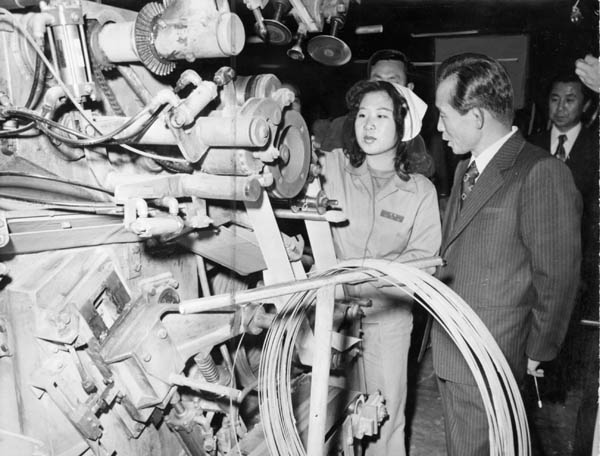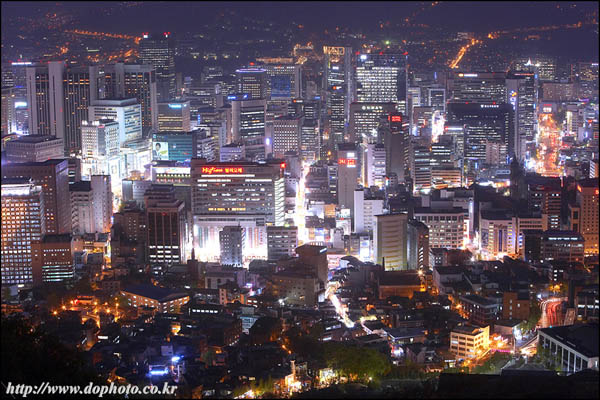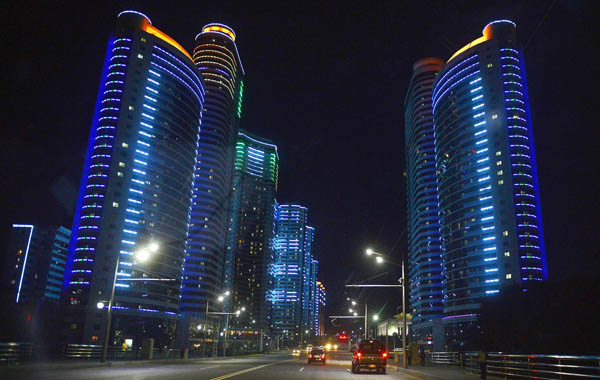From mirror images to portraits of contradiction

South Korean President Park Chung Hee inspects a factory. [JoongAng Photo]
And the ugliness of Park’s dictatorship got far more international publicity because of the nature of his patron, the United States, the relative openness of South Korea and Western foreign correspondents’ eagerness to portray the flaws of America’s ally. For the last three years of his life, Park had to put up with carping from an American president, Jimmy Carter, about his human rights abuses. Kim Il Sung and Mao Zedong had no such interest in making public North Korea’s dark underbelly.
But Park’s economic vision, derived from Japan’s miraculous rise from the ashes of World War II, was proven to work. North Korea’s, based on China’s collectivism, was guaranteed to fail.
Ahn Bok-soon, 60, remembers standing at the door of a textile factory in Cheongju, North Chungcheong, in March 1976. She had just graduated from Cheongju Girls High School. Her family couldn’t afford college.
“Watching all the girls my age walk into the factory, I just couldn’t go along with them. I wanted to study or work behind a desk, not as a factory worker,” she says.
“At the end of the day, I walked away and decided to take the civil service exam instead, which I passed.” Ah worked for 32 years at a public health center until her retirement in 2013.
Ahn’s career coincided with South Korea’s economic rise, the Miracle on the Han. And 30 years after she graduated from high school, she sent her son to the United States to study.
“Sending my son to study at a college in the U.S. would have been the last thing I could have imagined,” she says, “standing at that factory door.”

North Korean children suffer from starvation during the Arduous March of the mid 1990s. [JoongAng Photo]
But self-reliance is the flip side of international isolation, which hurt North Korea’s economy, not to mention the country spending some 30 percent of its national budget on its military.
North Korea’s per capita GDP rose from $384 in 1970 to $735 in 1990 (In South Korea, per capita GDP rose from $253 to $6,514 in the same period). But for six consecutive years from 1990, the Communist country registered negative economic growth and in the mid-1990s was hit by a great famine, the Arduous March.

View of central Seoul at night [JoongAng Photo]
“The North invested disproportionately in its defense on top of its stubborn pursuit of a self-reliant economic policy. … With mounting debts to cover the military spending, its economy crumbled in the late 1980s exacerbated by the collapse of the socialist block. The economic collapse was later aggravated by the natural disaster [the famine of the 1990s].”
“On the whole, people were still fond of Kim Il Sung at the time of his death in 1994,” Huh, the former obstetrician, says. Huh recalls crying helplessly in a crowd after hearing news of Kim Il Sung’s death.

View of skyscrapers in Pyongyang in 2012. [JoongAng Photo]
Defector Lee also recalls crying furiously under a baking sun on that fateful day 21 years ago.
“Of course I cried,” says Lee, who now works as an assembly line worker for a food manufacturing company in North Chungcheong. “How could I not have cried when my god had died? I was speechless and overwhelmed with the fear of what we were supposed to do next.”
It didn’t take long for Kim loyalists like Huh and Lee to find out the whole economic system in her country was about to crumble.
“For the five years after Kim’s death, North Korea was a country with no government,” says Lee. “It was total chaos with no rule of law.”
“Rations came to a complete halt in 1994,” says Huh. “People started dying of starvation. Hungry people rushed to factories to dismantle equipment to sell on the black market. Trafficking women to China for money was rampant. It was complete chaos.”
“Many died helplessly out of starvation,” recalls Lee. “In my town of Hoeryong in North Hamgyong Province, seven out of 20 households died of starvation during that period.”
Between 1996 and 2000, at least 330,000 North Koreans are estimated to have perished from starvation, according to Statistics Korea. But the number is assumed to be much higher, according to defectors, rising into the millions.
An official at South Korea’s Ministry of Unification said a large number of North Koreans perished in the famine because they “did not know how to feed themselves.”
Juche and self reliance was a national goal, not an individual one.
“But since then, people in the North have learned how to survive without government assistance by doing business in black markets that have sprung up in the country since the 1990s,” added the official.
Even so, by 2010, Huh and her 14 year-old didn’t have a penny and were scrounging mountainsides for food in northern Yanggang Province, which borders China. She decided her once beloved country literally had nothing for her anymore, including food. She decided to defect with her daughter.
North Korea’s per capita GDP plunged by 72.6 percent over a six year period from 1989 to 1995 from $811 to $222, while South Korea’s jumped to $12,337 from $5,738 over the same period, according to the Bank of Korea.
In 1997, just a few years after North Korea’s Arduous March, South Korea was devastated by the Asian financial crisis, which forced the Kim Young-sam government to request a humiliating $57 billion loan from the International Monetary Fund (IMF), the largest in history. In a single year, South Korea’s GDP shrank by 32.8 percent from $557 billion in 1997 to $374 billion in 1998. The chaebol were revealed to be barely profitable employment machines propped up by debt.
Massive layoffs were demanded by the IMF and it got them. Former executives sold sandwiches on sidewalks to office workers still lucky to have jobs. Former bankers drove taxis. Lifetime employment, a part of Korean corporate culture inherited from the Japanese, died in 1998.
Korea Inc. began to look like a Park Chung Hee pipe dream.
But Korea’s economic crisis coincided with an era of complete change on the political side. The second dictator, Chun Doo Hwan, gave up power in 1988 and democracy was restored. The Asian financial crisis hit just before power was being transferred to Kim Dae-jung, the first president from the opposite pole of Korean politics from his predecessors, the so-called liberals, a major political achievement for any young democracy. The liberals held power for ten years. Unlike North Korea, the South had become a land of freedom, flexibility and resilience.
It’s telling that the saddest victims of South Korea’s economic nadir committed suicide or were forced to sell sandwiches, while their counterparts in North Korea during the Arduous March would have killed for a sandwich. They died of starvation. Capitalism proved far more resilient than Communism, especially after the chaebol learned the lessons of the so-called IMF Crisis, such as proper managing of debt, making a profit and more transparent accounting.
It took only three years for the South’s GDP to return to pre-crisis levels, $561.8 billion in 2000, and it has risen every year since, except for 2001, 2008 and 2009.
North Korea’s per capita GDP peaked in 1987 ? 28 years ago - at $836 and has never recovered. The latest data from 2013 shows the figure at $621 while South Korea’s was 41 times larger at $25,993 in the same year.
For North Korea to ever start growing again, Prof. Yang says, it has to accept the economic models of China and Vietnam. Beijing has been imploring Pyongyang to do so for years. It has stubbornly refused.
Maybe the U.S. could have better luck, Yang says.
“Both Vietnam and China opened up their economies to the outside world after they forged diplomatic relations with the U.S.,” he says. “Pyongyang will shift its economic policy to one resembling China and Vietnam only after its regime’s survival is guaranteed [through forging diplomatic ties with Washington].”
The War Memorial of Korea in Seoul, which claims to be the largest memorial to a war in the world, has two monumental statues outside its main entrance. “Statue of Brothers” is a sentimental embrace between soldiers, one from the North and one from the South. “Bronze Sword and Life-giving Tree” is more abstract. It is a 31.5-meter (34.4-yard) upright sword split down the middle, symbolizing bifurcation of the Korean Peninsula.
Contemporary visitors find it perplexing and almost absurd that the land of “Gangnam Style,” Galaxy S phones, rampant cosmetic surgery and a rambunctious democracy is portrayed as an exact equal, the same towering height, as Kim Jong-un’s hermetically sealed, decrepit and hopeless land of gulags. Seventy years ago North and South Korea were indeed mirror images of each other, one land and one people sundered by the combatants of the 20th century’s Cold War. The big question is whether they will ever be equal again.
BY KANG JIN-KYU [kang.jinkyu@joongang.co.kr]










with the Korea JoongAng Daily
To write comments, please log in to one of the accounts.
Standards Board Policy (0/250자)